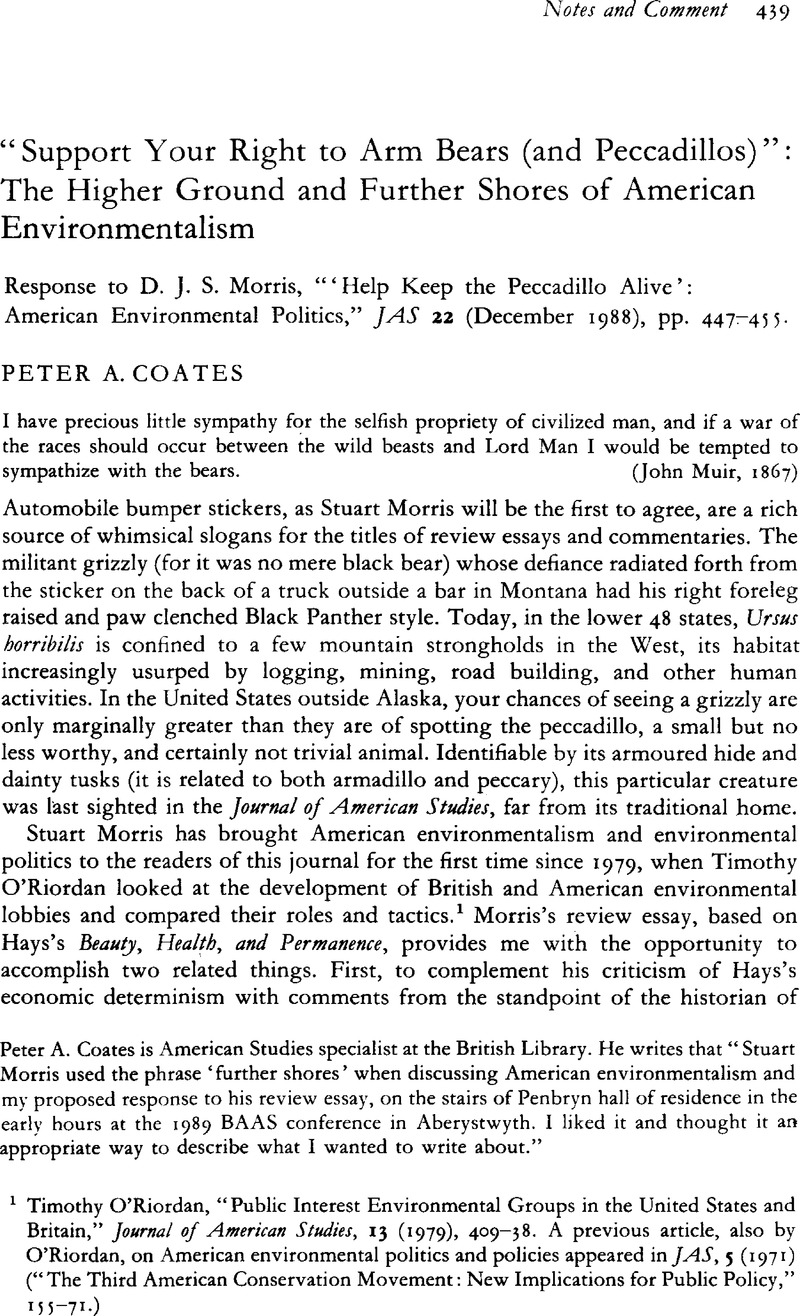Article contents
“Support Your Right to Arm Bears (and Peccadillos)”: The Higher Ground and Further Shores of American Environmentalism
Published online by Cambridge University Press: 16 January 2009
Abstract

- Type
- Notes and Comment
- Information
- Copyright
- Copyright © Cambridge University Press 1989
References
1 O'Riordan, Timothy, “Public Interest Environmental Groups in the United States and Britain,” Journal of American Studies, 13 (1979), 409–38.CrossRefGoogle Scholar A Previous article, also by O'Riordan, on American Environmental polital and policies appeared in JAS, 5 (1971)Google Scholar (“The Third American Conservation Movement:New Implications for Public Policy,” 155–71.)Google Scholar
2 For details of the strife within the Sierra Club, see McPhee, John, Encounters with the Archdruid: Narratives about a Conservationist and Three of his Natural Enemies (New York: Farrar, Straus and Giroux, 1971), 208–20.Google Scholar
3 Not all Sierra Club members agree with the club's policy of accepting advertising dollars from Detroit and major producers of CFCs like Du Pont. Club policy allows it to run adverts from corporations with whom the club disagrees on specific issues, and with whom it may even be locked in litigation. Advertising income, the argument goes, is crucial to the club's effective pursuit of its numerous programmes.
4 Morris remarks on the absence of a green party in the United States comparable to those that have emerged in Western Europe. American Greens have recently begun to contest elections modestly at the local level and to confer nationally. See Dominick, Raymond, “The roots of the Green movement in the United States and West Germany,” Environmental Review, 12 (Fall 1988), 1–30.Google Scholar
5 Environmental Action, 22 (01 1972), 4–6.Google Scholar
6 Ibid., 3 (October 1970), 13–14; 12 (December 1970), 11.
7 This was only a short reprieve. The reservoir was finally filled and this portion of the Stanislaus drowned in 1982.
8 Crist, Kathy, “For the Rivers, Come Hell or High Water,” Grassroots Profile, Sierra, 72 (05–06 1987), 61–65.Google Scholar
9 Mann, Carolyn, “Hazel Wolf: Ninety and Still Fighting,” Sierra, 73 (03–04 1988), 63–67.Google Scholar
10 Braxton, Jane, “The Gadfly Botanist of Plumas County,” Sierra, 73 (01–02 1988), 132–36.Google Scholar
11 Sierra, 73 (11–12 1988), 134.Google Scholar
12 For an example of eco-feminist insight and fulmination see Gray, Elizabeth Dodson, Why the Green Nigger? Re-Mything Genesis (Wellesley: Roundtable Press, 1979).Google Scholar
13 Nash, Roderick, The Rights of Nature: A History of Environmental Ethics (Madison: University of Wisconsin Press, 1988)Google Scholar, as reviewed in Sierra, 73 (11–12 1988), 118.Google Scholar See also Nash's preliminary statement, “Rounding Out the American Revolution: Ethical Extension and the New Environmentalism,” in Bailes, Kendall E., ed., Environmental History: Critical Issues in Comparative Perspective (Lanham: University Press of America, 1985), 242–58.Google Scholar This is not the place to discuss the numerous and critical differences between environmental ethics and animal liberationism. Suffice to say that the former is not particularly concerned with banning all forms of hunting, winning converts to veganism, and improving the lifestyle of battery chickens, laboratory mice and other man-made animals. The latter creed has little to do with the pursuit of ecological integrity and opposition to the destruction of wild animal habitat.
14 Stone, Christopher, “Should trees have standing? Towards Legal Rights for Natural objects,” Southern California Law Review, 45 (1972), 450–501Google Scholar; Earth and Other Ethics: The Case for Moral Pluralism (New York: Harper and Row, 1988).Google Scholar
15 At this point, it should be pointed out that there are those prepared to injure human life in their jihad on behalf of the unenfranchised and the voiceless – in this case, hallowed stands of old-growth redwood in coastal northern California. In one incident not too long ago, a logger was hurt when his chainsaw hit a long nail deliberately driven into one of these trees.
16 Mitchell, Robert Cameron, “How ‘Soft,’ ‘Deep,’ or ‘Left,’ Present Constituencies in the Environmental Movement for Certain World Views,” Natural Resources Journal, 20 (1980), 345–58.Google Scholar
17 Ibid., 347.
18 Leopold, Aldo, A Sand County Almanac (New York: Oxford University Press, 1949), 177.Google Scholar
19 Hays, Samuel P., “From Conservation to Environment: Environmental Politics in the United States since World War Two,” in Environmental History: Critical Issues in Comparative Perspective, 208.Google Scholar
20 Department of the Interior, Final Environmental Impact Statement, Proposed Trans-Alaska Pipeline (Washington, D.C.: U.S. Government Printing Office, 03 1972), Vol. 2, 217.Google Scholar
- 2
- Cited by


